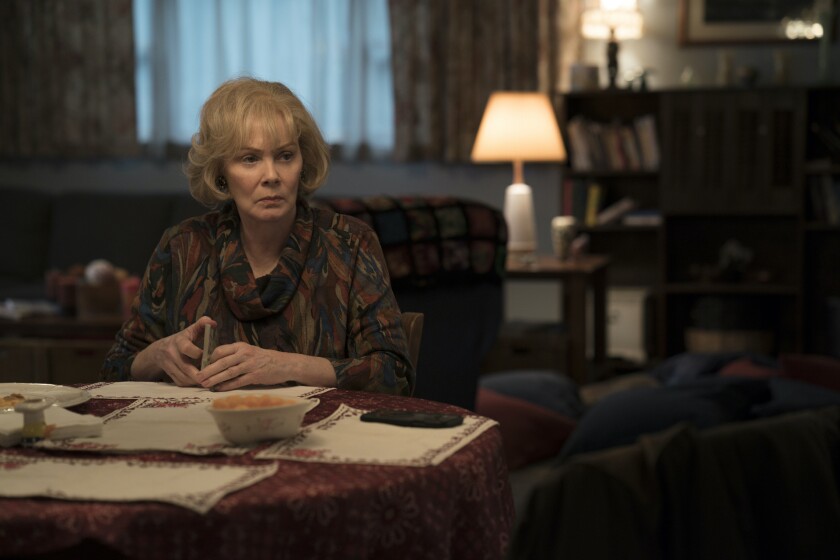29 April 2021 | MEREDITH BLAKE | Los Angeles Times (original link)
Barely 11 minutes into the first episode of “Mare of Easttown,” Kate Winslet goes where few actors have gone before.
She says the word “wooder.”
As in, what the good people of southeastern Pennsylvania call the stuff that comes out of the faucet.
Winslet has never been timid about much as a performer, especially accents. She played a German concentration camp guard in “The Reader,” a Brooklyn waitress in “Wonder Wheel” and a multilingual Armenian Polish computer executive in “Steve Jobs.”
But few sounds are as difficult to master as the rounded Os, erratic As, dropped consonants and smushed syllables of the Philadelphia accent — or Filelfia acksent, as the locals would say.
In the HBO limited series, Winslet stars as Mare Sheehan, a detective investigating the murder of a teenage girl in a fictional working-class town in Delaware County, Pa. — an area commonly referred to as Delco and known for its thick accent. It’s a place wherepeople root for the Iggles, eat hewgies and prefer youse guys as their second-person plural pronoun. And Mare, a vape-sucking, Rolling Rock-swilling former high school basketball star and middle-aged grandmother, fits right in linguistically.
The distinctive patois of southeastern Pennsylvania, heard in variations from Wilmington, Del., to South Jersey, has rarely been captured accurately onscreen, meaning it hasn’t permeated the culture the way other American accents have. Rocky Balboa, arguably cinema’s most famous Philadelphian, was played by a famous Noo Yawka who didn’t bother to disguise his origins. Suburban native son Bradley Cooper kept his Os in check in “Silver Linings Playbook,” set in the City of Brotherly Love. It has been deployed to comedic effect in sketches on “Saturday Night Live” and “Kroll Show,” but that’s about it.
Until “Mare of Easttown,” that is. The drama has received positive reviews, with Winslet and her costars, including Jean Smart, earning praise for rescuing a beloved regional accent from pop culture oblivion. But it took a lot of work.
“It is absolutely up there amongst the top two hardest dialects I’ve ever done,” says Winslet in a video call. She points to features like the “obviously tricky ‘o,’” formed closer to the front of the mouth so that home sounds like hewm, and “the way people from Delco kind of smush words together” so “words like wouldn’t and couldn’t become wuh-ent cuh-ent.” Another vexing quirk is the short “a,” which varies dramatically depending on the consonant before it, so sad is just sad, but mad is closer to “meeyad” — and a throwaway line like “really bad crap” becomes a linguistic minefield.
“The thing about doing a dialect is making it just disappear,” Winslet adds. “So it’s not like a voice that you hear the actor doing. It just evaporates. It’s something that I have to work on truly every day.”

Directed by Craig Zobel, the mystery focuses on a part of the country and a socioeconomic class that looms large in recent American politics but has gotten far less attention from pop culture. Creator Brad Ingelsby, who grew up in suburban Berwyn, Pa., was determined to accurately portray the region and what makes it unique, from Wawa coffee to those bleeping Os.
“Every once in a while I’d say, ‘Brad, my God, you gave me seven Os in that one sentence,” says Smart, who plays Winslet’s sharp-tongued mother and, despite the occasional hurdle, relished the chance to learn a new dialect.
The accent was important to Ingelsby because, he says, “we wanted to tell a story about this part of the world and this community in particular.” The screenwriter based the fictional Easttown on small towns like Coatesville and Drexel Hill (it also shares a name with the real-life Easttown Township in Chester County). “And if we were making the community a character, then we had to treat that character with as much honesty and authenticity as every other character in the series. And that meant having the people that populated the community sound true to life.”
To master the distinctive Delco accent, Winslet worked with her longtime dialect coach, Susan Hegarty, who first collaborated with her on “Titanic” and has helped her in more than a dozen projects since, including “Revolutionary Road” and “Contagion.”
“Kate is an accent nerd. She really takes pride in this,“ says Hegarty. “A lot of actors cannot bear to be bothered with mechanics because they just want to act. But Kate has a mind like a steel trap. She can absorb information without it upsetting her concentration as the character, which is a great gift. She wants to master everything she does. If it’s ‘Mildred Pierce,’ she wants to master how she chops the chickens.”
Hegarty says a key to doing any accent convincingly is not only grasping its distinctive vowel sounds but also being conscious of how they shift depending on where they land in a word or phrase. (In a terrible Southern accent, she says, all long “i” sounds become an “ahhhh.”) She found this was especially true of the Philly dialect.
“You really have to be precise with this accent,” says Hegarty, a native of San Francisco. “Thankfully, Kate loves being precise, but it’s also what drove her mad. She has publicly said that this is the only accent she’s ever done that made her throw things.”

The process on “Mare of Easttown” was continually evolving because the scripts kept changing, Winslet’s role was unusually talky, and production was halted for several months because of the COVID-19 pandemic.
But it followed the same general trajectory as all of Winslet and Hegarty’s collaborations over the last 25 years: Before filming began on location in Pennsylvania in late 2019, Hegarty provided Winslet a rough breakdown of the accent. From there they made creative decisions about how Mare would sound, “within a realm of what is plausible and accurate” for the character.
Meanwhile, Hegarty looked for primary sources — people from the same age group, time period and socioeconomic background as Mare who could provide sample recordings of their speech and serve as dialect models.
Susanne Sulby, a local dialect coach who worked with the rest of the cast on set throughout the production, interviewed dozens of people across the region and asked some to record word lists. Her tapes became very useful to Winslet and Hegarty, particularly as they wrestled with some of the accent’s more inconsistent sounds.
Ingelsby, whose wife has a Delco accent, also started recording his family as they talked in the car or played games at home. Spontaneous conversations like these were useful in getting to know the rhythm and melody of the Philly dialect, Hegarty says.
Winslet ultimately relied heavily on two sources, according to Hegarty. One was a Delco teacher named Trish Lauria who had “a really beautiful way of speaking and an accent that was strong enough that Kate could really hear it but soften it when she needed,” Hegarty says. Winslet would listen to recordings of her voice on the way to set each morning. The other was Christine Bleiler, a real detective in Chester County .

The goal isn’t to copy these people, Hegarty says, but to completely internalize their sounds the way a jazz musician might memorize scales and intervals in order to riff freely. “We’re programming everything into her ear, into her muscle memory, into her voice,” she says.
With each script, Hegarty identified a list of phrases for Winslet to practice (“Peco gas wants to notify,” “homeowner says for all we know,” “was it his nose?”), and pulled examples of similar sounds from the recordings of her primary sources.
She was on set for the first few months of production, helping Winslet warm up and giving her notes in between takes. The actress continued the same routine after Hegarty left, listening to tapes each morning on the way to work.
“I couldn’t really phonetically learn [the accent], I just had to keep hearing it, keep hearing it,” says Winslet, whose driver, John Dooley, was, at her request, a Delco native with a pronounced accent. “I mimic people a lot by accident. So I just needed to know that if I was going to be mimicking anyone, it better be the right sounds.” (Sometimes she had to ask him to dial it down. “I’d be like, ‘Dools, stop talking. That’s too strong!” Winslet says.)
Zobel recalls the different approaches the cast took to get the dialect right. Some actors would keep the accent going at craft services so it wouldn’t slip away.
Winslet, on the other hand, “was almost like ‘A Beautiful Mind,’” he says. “I remember going to her house one time and seeing, like, these crazy diphthongs and explanations of how to pronounce certain words that she had all over her apartment. She would draw all over scripts and had a very specific patterned way to do it. And because of that she was able to drop the accent when she wanted and come back to it at any time.”
Hegarty gets exasperated by people who think of an accent as a kind of costume. “You just go have a few fittings, and then you just go off and you do the accent, but it’s not like that. It’s a living thing. It has to come out of a living human being, and the living human being is the character, not the actor,” she says. “I know that Kate was utterly committed to the truth of this, and how it was the reflection of the inner life of Mare. The way we all speak is something that we do really unconsciously, but it says a lot about us.”
‘Mare of Easttown’
Where: HBO
When: 10 p.m. Sunday
Rated: TV-MA (may be unsuitable for children under the age of 17)
![]()
